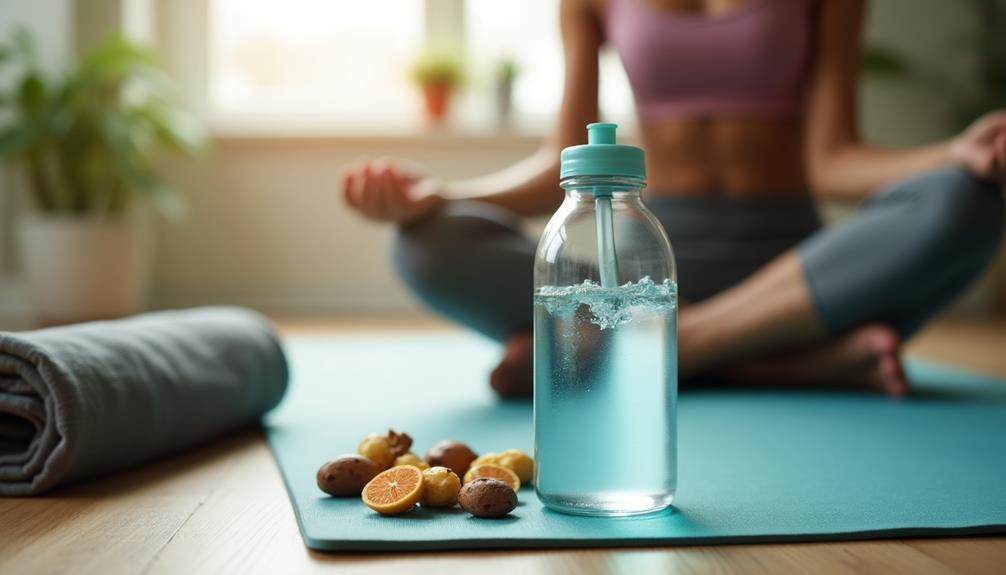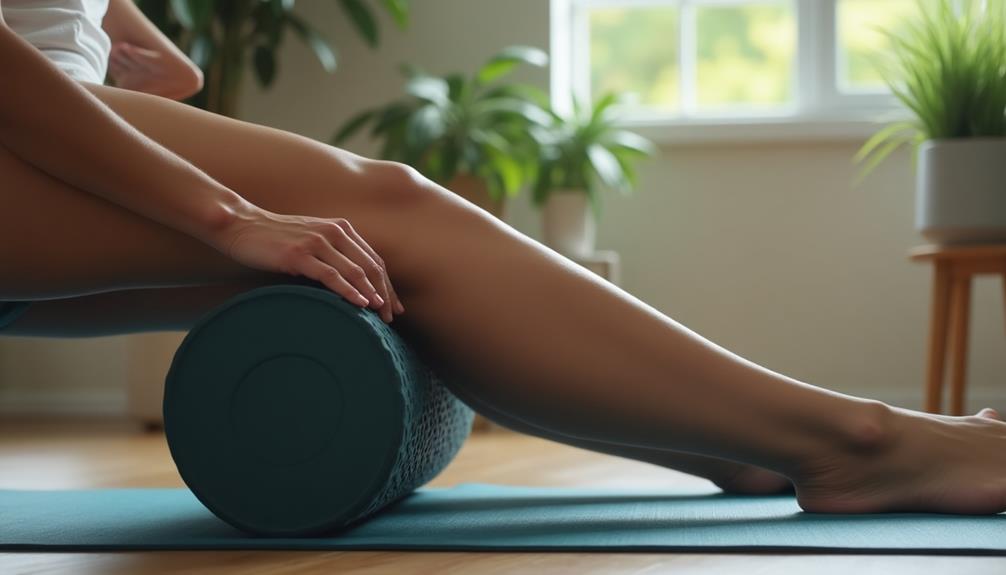To heal your muscles after intense workouts, start by hydrating properly—drink water soon after exercising. Next, prioritize protein intake with options like lean meats and dairy to aid repair. Don't skip cooling down and stretching; this reduces soreness and improves flexibility. Use foam rollers for myofascial release and better blood flow. Ensure you get 7-9 hours of quality sleep to support recovery. Try active recovery activities like yoga or swimming to keep blood circulating. Lastly, pay attention to your body—rest when you feel pain or fatigue. Each of these strategies plays a crucial role in your recovery journey.
Core Insights
- Stay hydrated by drinking water within 30 minutes post-workout to aid muscle recovery and prevent cramps.
- Prioritize protein intake from sources like chicken, Greek yogurt, and lentils to support muscle repair and growth.
- Incorporate foam rolling to relieve muscle tension, enhance blood flow, and reduce soreness effectively.
- Ensure adequate sleep, aiming for 7 to 9 hours, to promote muscle healing and recovery through hormone release.
- Engage in active recovery activities like walking or yoga to improve blood flow and flexibility without complete rest.
Hydrate Properly

When you finish an intense workout, don't just brush off hydration—it's necessary for muscle recovery. Your body loses a significant amount of water through sweat, and replenishing those fluids is crucial. Dehydration can lead to muscle cramps and fatigue, hindering your recovery process. For best hydration and replenishment of electrolytes, consider incorporating top coconut water brands into your post-workout routine. These natural beverages are packed with essential minerals and can effectively restore your body's fluid balance.
Aim to drink water within 30 minutes post-workout. This helps restore fluid balance and aids nutrient transport to your muscles. If you've had a particularly challenging session, consider adding an electrolyte drink to your routine. These drinks contain essential minerals that support muscle function.
Listen to your body; thirst is a sign you need more fluids. By prioritizing hydration, you'll enhance your recovery and prepare your muscles for the next challenge ahead.
Prioritize Protein Intake

| Food Source | Protein per Serving | Emotional Impact |
|---|---|---|
| Chicken Breast | 30g | Strength and power |
| Greek Yogurt | 20g | Nourishment and care |
| Lentils | 18g | Sustainability |
| Eggs | 6g | Wholesomeness |
| Almonds | 6g | Energy and liveliness |
Stretch and Cool Down

After prioritizing protein intake, it's important to focus on how you can enhance muscle recovery through stretching and cooling down. Incorporating compression sleeves during your cooldown can further support muscle recovery and reduce soreness.
Begin your cooldown routine immediately after your workout. Gradually reduce your activity level, allowing your heart rate to decrease. Spend five to ten minutes performing light aerobic exercises, like walking or slow cycling.
Next, stretch your major muscle groups gently. Hold each stretch for about 15 to 30 seconds, focusing on areas that feel tight. Incorporating static stretches helps improve flexibility and reduces muscle soreness.
Use Foam Rollers

Using foam rollers can be a game changer for muscle recovery after intense workouts. These tools help release muscle tension and improve blood flow, making recovery more efficient. High-density foam rollers are notably effective for deep tissue massage and myofascial release, offering intense pressure to target specific muscle groups. Textured surfaces on some rollers can mimic the hands of a massage therapist for more targeted relief.
To use a foam roller, start by positioning it under the muscle group you want to target. Apply your body weight to roll slowly over the foam, pausing on any tight spots. This technique, known as self-myofascial release, can alleviate soreness and enhance flexibility.
Aim to spend about 1-2 minutes on each muscle group, focusing on areas that feel particularly tight. Regular use of foam rollers can notably reduce muscle soreness and stiffness, helping you bounce back quicker for your next workout. Incorporating this simple practice into your routine can lead to better performance and overall well-being.
Get Enough Sleep

Recovery doesn't stop with foam rolling; getting enough sleep is just as important for muscle healing after intense workouts. Sleep allows your body to repair and regenerate muscle tissue. During deep sleep, your body releases growth hormones that aid in recovery and muscle growth.
Aim for 7 to 9 hours of quality sleep each night. Establish a consistent sleep schedule by going to bed and waking up at the same time daily. Create a restful environment by keeping your bedroom dark, cool, and quiet. Limit screen time before bed to help your body produce melatonin, the sleep hormone.
Consider Active Recovery

Although intense workouts can leave your muscles feeling fatigued, incorporating active recovery can greatly enhance your healing process. Active recovery involves low-intensity exercises that promote blood flow and aid in muscle repair. Instead of complete rest, you can engage in activities that keep you moving while allowing your body to recover. Here are three effective active recovery options:
- Walking: A brisk walk can help maintain circulation without straining your muscles.
- Yoga: Gentle stretching and poses can improve flexibility and relieve tension.
- Swimming: This low-impact activity provides resistance while being easy on your joints.
Incorporate Compression Gear

Active recovery methods can be complemented by incorporating compression gear into your routine. Compression garments, like sleeves or tights, apply pressure to your muscles. This can enhance circulation, which aids in reducing soreness and promoting recovery.
When you wear compression gear during or after workouts, it helps to minimize muscle vibration. This can lead to less fatigue and better performance. Choose gear that fits snugly but isn't overly tight, allowing for comfort and mobility.
Additionally, wearing compression clothing during rest periods can continue to support recovery. It's a simple yet effective way to give your muscles the extra help they need. By integrating compression gear into your post-workout routine, you're taking an important step toward faster healing and improved overall performance.
Apply Ice or Heat

- Ice: Use ice within the first 48 hours post-workout to reduce swelling and numb pain. Apply it for 15-20 minutes at a time, ensuring you have a barrier between the ice and your skin to prevent frostbite.
- Heat: After the initial recovery phase, heat can help relax and soothe tight muscles. Use a warm towel or heating pad for 15-20 minutes to enhance blood flow.
- Alternating: Sometimes, alternating ice and heat can provide best relief, combining the benefits of both methods for effective recovery.
Maintain a Balanced Diet

After addressing soreness with ice and heat, focusing on your nutrition can further support muscle recovery. A balanced diet is key to helping your muscles heal. Make sure to include plenty of protein, as it's essential for muscle repair and growth. Aim for lean sources like chicken, fish, beans, and legumes.
Don't forget about carbohydrates; they provide the energy you need for recovery. Whole grains, fruits, and vegetables are great choices. Healthy fats, like those found in avocados and nuts, also play a role in reducing inflammation.
Stay hydrated, too. Water is vital for overall recovery and helps transport nutrients to your muscles. By prioritizing a balanced diet, you'll give your body the tools it needs to recover efficiently after intense workouts.
Listen to Your Body

- Pain Levels: If you experience sharp or persistent pain, it's your body's way of signaling that something's wrong. Rest is essential in this case.
- Fatigue: Feeling unusually tired after a workout may indicate that you need more recovery time. Don't push through excessive tiredness.
- Mobility: Limited range of motion can signify that your muscles need more time to heal. Prioritize gentle stretching and movement work.
Frequently Asked Questions
How Long Should I Wait Before Working Out Again?
Did you know that 60% of injuries occur due to insufficient recovery? You should wait 48 to 72 hours before hitting the gym again, allowing your muscles to repair and grow stronger for your next workout.
Are There Specific Foods That Aid Muscle Recovery?
Yes, certain foods can boost your muscle recovery. Incorporate protein-rich options like chicken, fish, and legumes, along with carbohydrates from whole grains and fruits. Don't forget healthy fats from nuts and avocados for overall healing.
Can Supplements Speed up the Healing Process?
Supplements can enhance recovery, but they aren't magic. While they provide nutrients, your body's healing hinges on balanced nutrition and rest. So, combine supplements with proper diet and sleep for best muscle recovery.
What Signs Indicate I Need Professional Help?
If you experience persistent pain, swelling, or inability to move a muscle, it's time to seek professional help. Also, if symptoms worsen despite home care, don't hesitate to consult a healthcare provider for guidance.
Is It Okay to Take Pain Relievers During Recovery?
It's generally okay to take pain relievers during recovery if discomfort interferes with your daily activities. Just be sure to follow dosage guidelines and consult a healthcare professional if you have concerns or ongoing pain.

